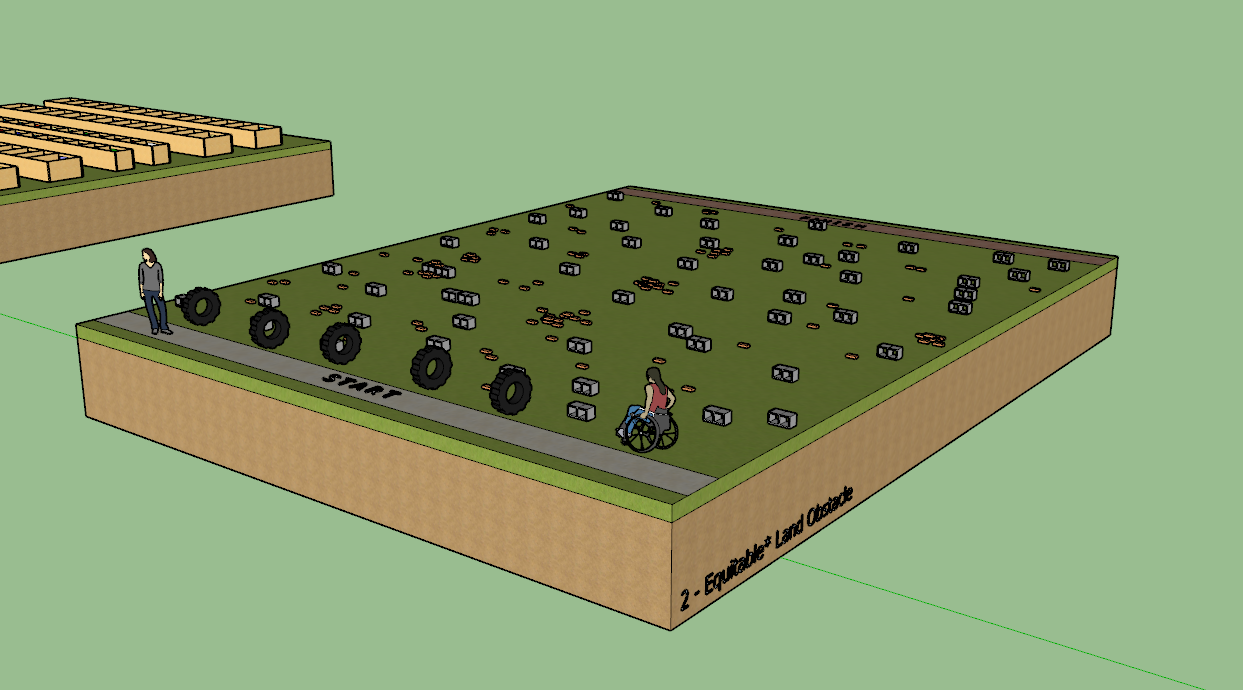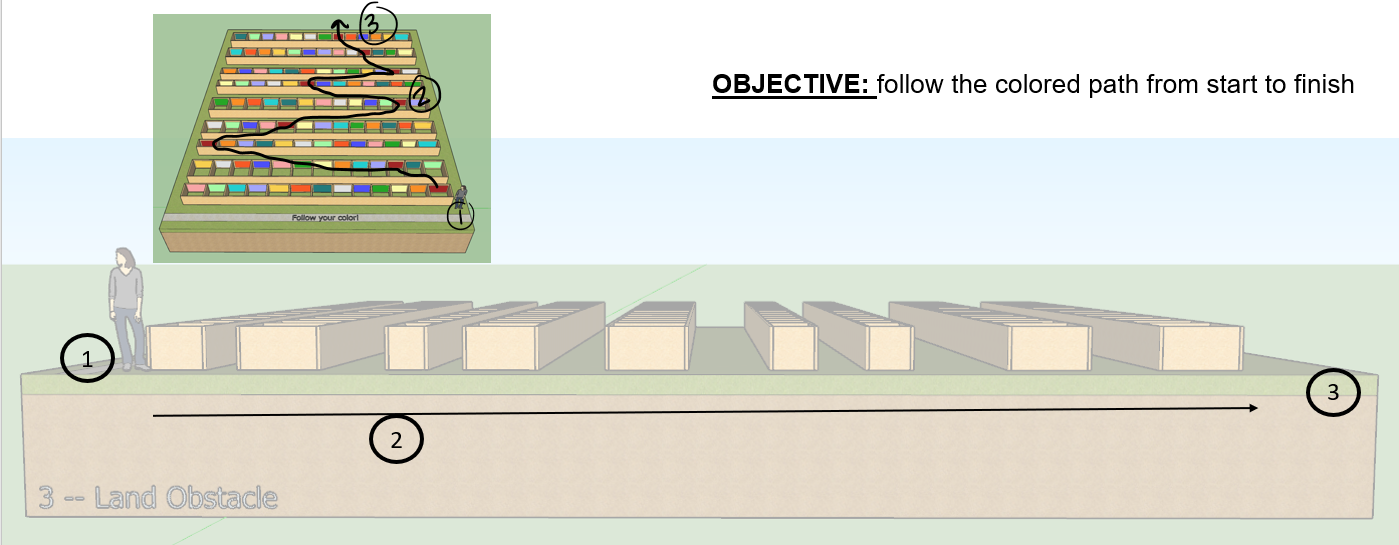BOAR Race Project
In this semester’s Honors Studio, we have been collaborating with the Human Resources Development Council (HRDC) of Bozeman to design obstacles for the Blueprint Obstacle Adventure Race (BOAR), scheduled for August 2020. This race, as stated on the official BOAR website, is an inaugural 1k and 5k race to support and spread awareness of youth experiencing homelessness in our community. Our challenge was to design obstacles that allow people of all ages and abilities to participate together in one race.
Research
On February 16th, 2020, the Honors ARCH 152 class went to a Spartan Race in San Jose, CA to conduct research and observe the mechanics behind hosting an obstacle race of this type and magnitude. The resulting observations and conclusions from this research will serve to aid in the design process for the Blueprint Obstacle Adventure Race. This research was highly informative in terms of what is required for an event of this nature. Participating in the race and navigating the process from start to finish allowed us insight into what the participants of the BOAR may experience and how we can tailor our event to be as enjoyable as possible for participants, volunteers, and facilitators alike.
Overview
There were four distinct parts of the Spartan Race event:
● the registration confirmation
● the pre-race period
● the race itself
● the post-race period
These components will all be present in the BOAR, and the knowledge we gained from the Spartan Race will serve to inform our decisions regarding race design, organization, and facilitation.
Registration Confirmation
Upon arriving at the race, the first task was to retrieve a packet from the registration confirmation desk that contained materials necessary for the race, such as a headband with one’s race number and a wristband with one’s start time. It is extremely important to have clear signage and organization leading to the desks as well as at the desks themselves in order to eliminate confusion for participants as they arrive. Additionally, the Spartan Race required a photo ID to confirm identification and allow entry into the event space. If we choose to use this method for participant check-in, it will be important to clarify this requirement prior to the date of the race. After entry into the main event space, the Spartan Race utilized A-frame folding signs with simple “1-2-3” steps that outlined the necessary actions to take from arrival to the start of the race.
Pre-Race Period
There was a large grassy area dedicated to self-structured recreation for both participants and spectators to enjoy before and after the race. Along one edge of the large space, adjacent to the entrance, were bathrooms and a bag check service. These two services were well-placed. The majority of the green space was open, allowing people to mill about, and the edges of the space were primarily occupied by food, drink, and merchandise vendors. This layout was adequate; however, some signage and/or maps detailing the locations of the vendors, bag check, bathrooms, etc. would have been useful.
The Race
Our physical participation in the race was crucial to this research. Through our engagement, we were able to experience first-hand the benefits and drawbacks of their designs, and we are now able to take those observations and apply them in our own project. The Spartan Race was organized so that approximately 100 participants began the race every 15 minutes. This seemed to be a fairly successful mechanism to mitigate the bottle-necking effect that naturally occurs with crowds that size. The layout and size of the Spartan Race path provided ample room for the runners and obstacles. In general, the landscape/path allowed for people to easily navigate around each other, allowing participants to run at their own pace and pass each other when needed. There were a few points at which the path narrowed and it became more difficult to pass others, but generally, this was not a significant issue. At no point did the path have to double back on itself. In seeing this, it raised concerns for the creation of our own obstacle course in terms of maintaining adequate flow and space in order to avoid bottlenecks, as the current layout has multiple points where the trail doubles back on itself. As we continue to develop the plans and layout for our obstacle course race, we will give more consideration to the layout of the path and the means by which we can design a course that will avoid congestion. At some obstacles, there was moderate bottlenecking. This effect was lessened in the obstacles that allowed many people to pass through at one time. We intend to design our obstacles in a way that will allow many runners to participate in the obstacle simultaneously in order to maintain proper traffic flow.
Post-Race Period
The end of the race was clearly marked with a large, overhead finish line. 5–10 yards past the finish line was a photographer who took a finishing photo, which would be good to implement in our design. Past the photographer was the booth at which one received a t-shirt. This series/layout of finishing actions functioned successfully. Because the Spartan Race included multiple mud obstacles, they provided a washing station and changing tents, located across the field from the finish line. This setup was very poor. The runoff from the washing station hoses flowed directly into the changing tents, so the ground in the tents was completely flooded and muddy. Additionally, there were only a few tables on which to place one’s clean clothes, bags, etc., and many people were left without a space to set their belongings. If we choose to incorporate water/mud obstacles in our race, we will give more consideration to the topography of our site as well as the layout of our stations in order to remedy these issues we encountered.
Summary
This experience was extremely beneficial. As a group, we learned how to structure our race and design obstacles that will satisfy the needs and mission of the HRDC and BOAR. We look forward to this amazing design opportunity and a successful partnership with the HRDC.
Design
This project is still in progress; thus, my designs are still evolving.
Equitable Water Obstacle
1.Grab bucket(s)
2. Go to lake, fill buckets with water
3. Return to start line
4. Pour water down trough
5. Water flows down trough into bucket at end
6. Participants must fill entire bucket at end in order to move on
7. Drag full bucket back to lake and dump water; put empty bucket back under trough
•fosters a sense of futility which homeless youth face
•relates to the idea of having to divert ones resources/time/money to things that she might rather put toward something else
•Height of trough: 3 feet; allows accessibility for participants in wheelchairs, participants of any height
•Multiple bucket sizes (ranging from small pails to 5 gallon buckets); allows participation regardless of physical strength
•Volunteers can finish step 7 (dragging full water bucket back to lake to be emptied) for participants who are unable to do so
Equitable Land Obstacle
1.Get one of the tires at the start line
2.Roll tire through obstacles
3.Reach finish line
4.Carry tire back to start line; participants then able to move on with the race
•Sense of having obstacles beyond one’s control making the path to one’s goal more difficult
•Fosters sense of instability which homeless youth face
•Spacing between bricks/cinder blocks on lateral edges allows for passage of wheelchair or stroller – those who are wheelchair-bound have opportunity to carry tire through in lap if desired
•Can obtain a variety of tire sizes to accommodate different human sizes/strengths
Land Obstacle
1.Select your color path at the start line
2.Navigate through the boxes and around others as you progress through the obstacle, staying on the “path” created by your color
3.Once you’ve reached the finish line, you may move on
•Relates to the role of interpersonal communication/cooperation in the fight against youth homelessness; working together will get everyone to their destination faster an easier than if everyone is only trying to help themselves












